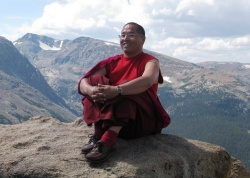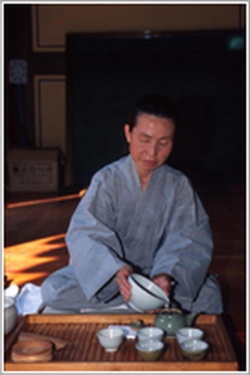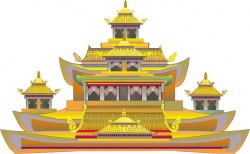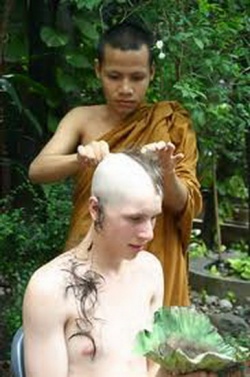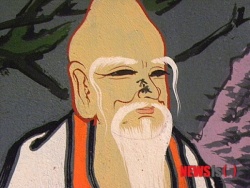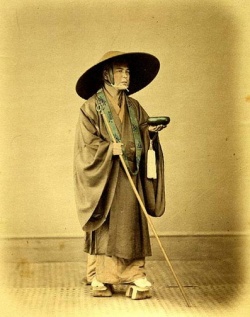Clearing Up Uncertainties About Basis and Expression
These excerpts are from Dakpo Tashi Namgyal's Clarifying the Natural State, which is a commentary to his work, Mahamudra: The Moonlight - Quintessence of Mind and Meditation; keep in mind, this is skipping stages of meditation, which precede these instructions.
Clearing Up Uncertainties About Basis and Expression
This has four points:
Resolving that thoughts are mind
Resolving that perceptions are mind
Investigating the calm and the moving mind
Resolving that all experience is nonarising
Resolving That Thoughts Are Mind
Assume the same posture as before. Let your mind be evenly composed as aware emptiness. From within this state project a vivid thought, such as anger. Look directly into it and thoroughly investigate from what kind of substance or basis it arose.
Perhaps you suppose that it arose from this state of empty and aware mind itself. If so, examine whether it is like a child born from its mother or like light shining from the sun. Or is it the mind that becomes the thought?
Next, observe the way in which it remains. When it appears in the form of anger, examine whether this anger is accompanied by the fetter of intense clinging to things as being real or whether it is simply an appearance of anger, an openness in which there is no identity to take hold of.
Finally, observe how a thought departs. Is the thought stopped or does it dissolve? If it is stopped, who stopped it or what circumstance made it stop? If it dissolves, examine whether it dissolves due to some circumstance or whether it dissolves by itself.
In the same way, a variety of gross and subtle thoughts should be examined to gain some experience. If the meditator holds a wrong understanding, it should be eliminated with a counter-argument and a hint given. After that, the meditator should once more continue examining.
You may not have found that the thought arose from a particular location in a particular way, that it dwells in a particular shape or form or that it departs to a particular place. Nevertheless, your concepts about whether thought are mind are different, whether they are related as inside and outside, or as the body and its limbs and so forth must be destroyed. You must experience that the various thoughts, in whatever form they arise, are an empty appearance and not a definable entity. You must recognize that they arise out of yourself and dissolve into yourself. Since mind is unconfined, you must become certain that it is mind that merely appears or is seen as being thoughts. You must resolve that thoughts and mind are indivisible.
Take the metaphor of a wave on water. The wave is nothing other than the water, and yet it is seen as a wave. Although it appears as a wave, it has never changed from being of the nature of water. In the same way, with the various types of thoughts, from the very moment they appear, they are nothing other than the aware emptiness of unidentifiable mind.
Moreover, since this mind is unconfined, it does appear as a variety of thoughts. Even though it appears as them, it has not changed from being the aware emptiness of the mind that is not a definable entity. You must settle this point decisively. You must gain the experience of certainty in the fact that the various types of thoughts are mind.
Similarly, give rise to a happy or a sad thought and investigate whether there is any difference in their identity. In this way, also become certain in regard to opposing types of thoughts."
Investigating the Calm and the Moving mind
Maintain the same physical posture as mentioned before. Let your mind be serenely calm in the state of aware emptiness. Now, investigate by looking directly into it.
While in this state of serene calm allow a thought to vividly stir. Investigate it too by looking directly into it.
Next, investigate the two instances of calm and thought movement to see if there is any difference in their arrival, remaining and departure or in their definable identity.
If there is a difference between remaining calmly and an abrupt movement of thought, examine to see if their difference consists in being better or worse, empty or not empty, having or not having an identity, and between being or not being identifiable.
If there is no difference, investigate to see if their lack of disparity consists in being identical or in being similar while different.
If identical, investigate how they are identical at the beginning, middle and end. If similar, examine how they are similar. Investigate in this way to gain some experience.
In case an incorrect understanding is held, it should be stopped with a counter-argument, a hint should be given and the investigation resumed.
Turning away from the belief that these two -- serene calm and abrupt thought movement -- are of entirely different substances, you must experience that they are the same mind, the mind that is identical in being rootless and intangible, and in being an aware emptiness that is self-knowing and naturally pure.
This being so, whichever of the two happens, there is no need to accept or reject, repress or encourage. Rather, you should become confident that this aware emptiness is naturally free -- in the very stillness when calm and in the very arising when thoughts occur."
Steps of Pointing-Out Instruction
This has two parts:
Pointing out innate mind-essence
Pointing out innate thinking
Pointing out innate perception
Pointing Out Innate Mind-Essence
First, when giving the pointing-out instruction, no one else should be present besides the master and disciple. If you prefer, assume the posture as before. Then the master says:
"Let your mind be as it naturally is without trying to correct it. Now, isn't it true that all your thoughts, both subtle and gross, subside in themselves? Rest evenly and look to see if this mind doesn't remain calm in its own natural state."
The master lets the disciple look.
"That's called shamatha...."
"During this state, do not become dull, absent-minded or apathetic. Is it not true that you cannot verbally formulate that the identity of this mind is such-and-such, nor can you mentally form a thought of it? Rather, isn't it a totally unidentifiable, aware, unconfined and lucid wakefulness that knows itself by itself?
"Within the state of evenness, look to see whether it isn't an experience without any 'thing' experienced."
The master then lets the disciple look.
"That's called vipashyana."
-
"Here, these two are mentioned sequentially, but in actuality this kind of shamatha and vipashyana are not separate. Rather, look to see if this shamatha isn't the vipashyana that is an unidentifiable, self-knowing, natural awareness. Also look to see if this vipashyana isn't the shamatha of abiding in the natural state untainted by conceptual attributes. Rest evenly and look!"
The master lets the disciple look.
"That's called the unity of shamatha and vipashyana."
-
"Both are contained within your present mind. Experiencing and recognizing this is called the birth of meditation practice.
"This is what is given many names, such as buddha-mind, mind-essence of sentient beings, nonarising dharmakaya, basic natural state, innate mind, original wakefulness, Mahamudra, and so forth. And this is what all the sutras and tantras, true treatises and instructions aim at and lead to."
-
Having said this, if the matser prefers, he can inspire further confidence by giving relevant quotations from the scriptures. Otherwise, it may not be necessary to say more than the following, since some people of lesser intelligence may get confused when the explanation is too long.
"The meaning in a nutshell is this: allow your mind to be as it naturally is, and let thoughts dissolve in themselves. This is your innate mind, which is an unidentifiable, self-knowing, natural awareness. Remain one-pointedly in its continuity and do not get distracted.
"During the daily activities between breaks as well, try to keep this kind of mindfulness undistractedly as much as you can.
"It is important to continue training persistently for a couple of days. Otherwise, there may be a danger of this seeing of mind-essence, which you ahve pursued through various means, slipping away."
"The meditator should therefore train in focusing on that for a couple of days.
Pointing Out Innate Thinking
Second, the meditator should now assume the correct posture in front of (the master, and be told the following):
"Let your mind remain in its natural way. When thoughts have subsided, your mind is an intangible, aware emptiness. Be undistracted and look directly into the identity of this naked state!
"At this moment, allow a feisty thought, such as delight, to take form. The very moment it vividly occurs, look directly into its identity from within the state of aware emptiness.
"Now, is this thought the intangible and naked state of aware emptiness? Or is it absolutely no different from the identity of innate mind-essence itself? Look!"
Let the meditator look for a short while.
The meditator may say, "It is the aware emptiness. There seems to be no difference." If so, ask:
"Is it an aware emptiness after the thought has dissolved? Or is it an aware emptiness by driving away the thought from meditation? Or, is the vividness of the thought itself an aware emptiness?"
If the meditator says it is like one of the first two cases, he had not cleared up the former uncertainties and should therefore be set to resolve this for a few days.
On the other hand, if he personally experiences it to be like the latter case, he has seen identity of thought and can therefore be given the following pointing-out instruction:
"When you look into a thought's identity, without having to dissolve the thought and without having to force it out by meditation, the vividness of the thought is itself the indescribable and naked state of aware emptiness. We call this seeing the natural face of innate thought or thought dawns as dharmakaya.
"Previously, when you determined the thought's identity and when you investigated the calm and the moving mind, you found that there was nothing other than this intangible single mind that is a self-knowing, natural awareness. It is just like the analogy of water and waves.
"This being so, is there any difference between calm and movement?
"Is there any difference between thinking and not thinking?
"Is it better to be serenely calm? Do you need to be elated about it?
"Is it worse when a thought abruptly arises? Do you need to be unhappy about it?
"Unless you perceive this hidden deception, you will suffer the meditation famine. So, from now on, when a thought does not arise you need not deliberately make one arise so as to train in the state of its arising, and when the thought does arise you need not deliberately prevent it, so as to train in the state of its nonarising. Thus, do not be biased toward calm or movement.
"The principle for this thought can be applied to all thoughts. However, the meditator should train for a while in simply making use of thoughts, so when no thoughts arise, conjure one up on purpose and sustain its essence. Otherwise, there is a danger of losing sight of the identity of thoughts.
The meditator should, therefore, be instructed to continue practicing diligently for several days. If it is preferably, bring in some quotations to instill certainty.
Pointing Out Innate Perception
Third, the physical posture and so forth should be kept just as before. Then ask:
"While in the composure of the natural state, allow a visual perception, such as that of a mountain or a house, to be vividly experienced. When looking directly at the experience, is this perception itself an intangible aware emptiness? Or, is it the aware and empty nature of mind? Look for a while to see what the difference between them is."
Let the meditator look. He may say, "There is no difference. It is an intangible, aware emptiness." If so, then ask:
"Is it an aware emptiness after the perceived image has disappeared? Or, is the image an aware emptiness by means of cultivating the aware emptiness? Or, is the perceived image itself an aware emptiness?"
If the answer comes that it is one of the first two cases, the meditator has not thoroughly investigated the above and should therefore once more be sent to meditate and resolve this.
If he does experience that the vividly perceived visual image itself -- unidentifiable in any way other than as a mere presence of unconfined perception -- is an aware emptiness, the master should then give this pointing-out instruction:
"When you vividly perceive a mountain or a house, no matter how this perception appears, it does not need to disappear or be stopped. Rather, while this perception is experienced, it is itself an intangible, empty awareness. This is calledseeing the identity of perception."
"Previously you cleared up uncertainties when you looked into the identity of a perception and resolved that perceptions are mind. Accordingly, the perception is not outside and the mind is not inside. It is merely, and nothing other than, this empty and aware mind that appears as a perception. It is exactly like the example of a dream-object and the dreaming mind.
"From the very moment a perception occurs, it is a naturally freed and intangible perceiving emptiness. This perceiving yet intangible and naked state of empty perception is called seeing the natural face of innate perception or perception dawning as dharmakaya.
"This being so, 'empty' isn't something better and 'perceiving' isn't something worse, and perceiving and being empty are not separate entities. So, you can continue training in whatever is experienced. When perceiving, in order to deliberately train in perception, there is no need to arrest it. When empty, in order to deliberately train in emptiness, you do not need to produce it.
"Whenever you recall the mindful presence of practice, all of appearance and existence is the Mahamudra of dharmakaya, without the need to adjust, accept or reject. And so, from now on, continue the training without being biased toward perception or emptiness by repressing or encouraging either of them.
"Nevertheless, for a while allow various kinds of perceptions to take place. While perceiving it is essential to be undistracted from sustaining the unidentifiable essence."
Thus, let the meditator train for several days. If it is preferred, bring in some quotations to instill certainty."
